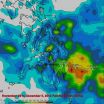(Press-News.org) Highlanders in Tibet and Ethiopia share a biological adaptation that enables them to thrive in the low oxygen of high altitudes, but the ability to pass on the trait appears to be linked to different genes in the two groups, research from a Case Western Reserve University scientist and colleagues shows.
The adaptation is the ability to maintain a relatively low (for high altitudes) level of hemoglobin, the oxygen-carrying protein in red blood cells. Members of ethnic populations - such as most Americans - who historically live at low altitudes naturally respond to the thin air by increasing hemoglobin levels. The response can help draw oxygen into the body, but increases blood viscosity and the risks for thrombosis, stroke and difficulties with pregnancies.
By revealing how populations can live in severe environments, the research may provide insight for managing high-altitude sickness and for treating low blood-oxygen conditions such as asthma, sleep apnea, and heart problems among all people.
How long such physiological and genetic changes take remains a question. The researchers found the adaptation in an ethnic group that has lived high in mountains of Ethiopia for at least 5,000 years, but not among a related group that has lived high in the mountains for 500 years.
The findings are reported today in the open-access online journal PLoS Genetics.
In their first comparison, the researchers found that the genes responsible for hemoglobin levels in Tibetans don't influence an ethnic group called the Amhara
The Amhara have lived more than a mile high in the Semien Mountains of northern Ethiopia for 5,000 to 70,000 years. A different variant on the Amhara genome, far away from the location of the Tibetan variant, is significantly associated with their low hemoglobin levels.
"All indications are we're seeing convergent evolution," said Cynthia Beall, professor of anthropology at Case Western Reserve University and one of the leaders of the study. Convergent evolution is when two separate populations change biologically in a similar way to adapt to a similar environment yet use different mechanisms.
"These were two different evolutionary experiments," Beall said of the mountain dwellers in Tibet and Ethiopia. "On one level—the biological response—they are the same. On another level—the changes in the gene pool—they are different."
Beall investigated the adaptations and genetic links with Gorka Alkorta-Aranburu, David Witonsky, Jonathan K. Pritchard and Anna Di Rienzo, of the University of Chicago department of human genetics, and Amha Gebremedhin of Adis Ababa University's department of internal medicine in Ethiopia.
In addition to studying the Amhara, the researchers looked for changes in physiology and genetics among a related ethnic group, the Oromo, who have lived more than a mile above sea level in the Bale Mountains of southern Ethiopia for 500 years.
They found no long-term adaptation and no genetic changes related to a low-oxygen environment.
They found the Omoro had high levels of hemoglobin, as would be expected for a lowland population.
Using the same samples collected from the Amhara and Oromo, the researchers are now studying biological traits among the groups, including ventilation, and the influence of vasoconstrictors and vasodilators on blood flow, and searching for associations with genes.
They also plan to continue research and study blood flow, especially through the heart and lungs of the highlanders, and to test the metabolic rate of mitochondria that use oxygen to create the energy on which our cells and we operate.
"We also want to find whether people with the variants for low hemoglobin levels have more children and a higher survival rate," Beall said. "That's the evolutionary payoff."
### END
Different genes behind same adaptation to thin air
Apparent example of convergent human evolution on 2 continents
2012-12-07
ELSE PRESS RELEASES FROM THIS DATE:
Deception can be perfected
2012-12-07
EVANSTON, Ill. --- With a little practice, one could learn to tell a lie that may be indistinguishable from the truth.
New Northwestern University research shows that lying is more malleable than previously thought, and with a certain amount of training and instruction, the art of deception can be perfected.
People generally take longer and make more mistakes when telling lies than telling the truth, because they are holding two conflicting answers in mind and suppressing the honest response, previous research has shown. Consequently, researchers in the present study ...
Gladstone scientists discover novel mechanism by which calorie restriction influences longevity
2012-12-07
SAN FRANCISCO, CA—December 6, 2012—Scientists at the Gladstone Institutes have identified a novel mechanism by which a type of low-carb, low-calorie diet—called a "ketogenic diet"—could delay the effects of aging. This fundamental discovery reveals how such a diet could slow the aging process and may one day allow scientists to better treat or prevent age-related diseases, including heart disease, Alzheimer's disease and many forms of cancer.
As the aging population continues to grow, age-related illnesses have become increasingly common. Already in the United States, ...
Attitudes predict ability to follow post-treatment advice
2012-12-07
SAN ANTONIO, TX (December 6, 2012)—Women are more likely to follow experts' advice on how to reduce their risk of an important side effect of breast cancer surgery—like lymphedema—if they feel confident in their abilities and know how to manage stress, according to new research from Fox Chase Cancer Center to be presented at the 2012 CTRC-AACR San Antonio Breast Cancer Symposium on Saturday, December 8, 2012.
These findings suggest that clinicians must do more than just inform women of the ways they should change their behavior, says Suzanne M. Miller, PhD, Professor ...
Seeing in color at the nanoscale
2012-12-07
If nanoscience were television, we'd be in the 1950s. Although scientists can make and manipulate nanoscale objects with increasingly awesome control, they are limited to black-and-white imagery for examining those objects. Information about nanoscale chemistry and interactions with light—the atomic-microscopy equivalent to color—is tantalizingly out of reach to all but the most persistent researchers.
But that may all change with the introduction of a new microscopy tool from researchers at the Department of Energy (DOE)'s Lawrence Berkeley National Laboratory (Berkeley ...
Notre Dame research reveals migrating Great Lakes salmon carry contaminants upstream
2012-12-07
Be careful what you eat, says University of Notre Dame stream ecologist Gary Lamberti.
If you're catching and eating fish from a Lake Michigan tributary with a strong salmon run, the stream fish — brook trout, brown trout, panfish — may be contaminated by pollutants carried in by the salmon.
Research by Lamberti, professor and chair of biology, and his laboratory has revealed that salmon, as they travel upstream to spawn and die, carry industrial pollutants into Great Lakes streams and tributaries. The research was recently published in the journal Environmental Science ...
Silver nanocubes make super light absorbers
2012-12-07
DURHAM, N.C. -- Microscopic metallic cubes could unleash the enormous potential of metamaterials to absorb light, leading to more efficient and cost-effective large-area absorbers for sensors or solar cells, Duke University researchers have found.
Metamaterials are man-made materials that have properties often absent in natural materials. They are constructed to provide exquisite control over the properties of waves, such as light. Creating these materials for visible light is still a technological challenge that has traditionally been achieved by lithography, in which ...
NASA compiles Typhoon Bopha's Philippines Rainfall totals from space
2012-12-07
NASA's Tropical Rainfall Measuring Mission, or TRMM satellite can estimate rainfall rates from its orbit in space, and its data is also used to compile estimated rainfall totals. NASA just released an image showing those rainfall totals over the Philippines, where severe flooding killed several hundred people. Bopha is now a tropical storm in the South China Sea.
High winds, flooding and landslides from heavy rains with Typhoon Bopha have caused close to 300 deaths in the southern Philippines.
The TRMM satellite's primary mission is the measurement of rainfall in the ...
UC Davis study shows that treadmill testing can predict heart disease in women
2012-12-07
(SACRAMENTO, Calif.) — Although there is a widespread belief among physicians that the exercise treadmill test (ETT) is not reliable in evaluating the heart health of women, UC Davis researchers have found that the test can accurately predict coronary artery disease in women over the age of 65. They also found that two specific electrocardiogram (EKG) indicators of heart stress during an ETT further enhanced its predictive power.
Published in the December issue of The American Journal of Cardiology, the study can help guide cardiologists in making the treadmill test ...
TGen-US Oncology data guides treatment of metastatic triple-negative breast cancer patients
2012-12-07
PHOENIX, Ariz. — Dec. 6, 2012 — Genomic sequencing has revealed therapeutic drug targets for difficult-to-treat, metastatic triple-negative breast cancer (TNBC), according to an unprecedented study by the Translational Genomic Research Institute (TGen) and US Oncology Research.
The study is published by the journal Molecular Cancer Therapeutics and is currently available online.
By sequencing, or spelling out, the billions of letters contained in the genomes of 14 tumors from ethnically diverse metastatic TNBC patients, TGen and US Oncology Research investigators found ...
General thoracic surgeons emerge as leading providers of complex, noncardiac thoracic surgery
2012-12-07
While thoracic surgeons are traditionally known as the experts who perform heart surgeries, a UC Davis study has found that general thoracic surgeons, especially those at academic health centers, perform the vast majority of complex noncardiac operations, including surgeries of the esophagus and lungs.
The authors said their results, published in the October issue of The Annals of Thoracic Surgery, support the designation of general thoracic surgery as a distinct specialty, which will benefit patients when selecting surgeons for specific procedures.
"In years past, ...
LAST 30 PRESS RELEASES:
Jeonbuk National University study shows positive parenting can protect adolescents against self-harm
Surface-engineered ZnO nanocrystals to tackle perfluoroalkyl substance contamination
This new understanding of T cell receptors may improve cancer immunotherapies
A new fossil face sheds light on early migrations of ancient human ancestor
A new immunotherapy approach could work for many types of cancer
A new way to diagnose deadly lung infections and save lives
40 percent of MRI signals do not correspond to actual brain activity
How brain-inspired algorithms could drive down AI energy costs
Gum disease may be linked to plaque buildup in arteries, higher risk of major CVD events
Contrails are a major driver of aviation’s climate impact
Structure of dopamine-releasing neurons relates to the type of circuits they form for smell-processing
Reducing social isolation protects the brain in later life
Keeping the heart healthy increases longevity even after cancer
Young adults commonly mix cannabis with nicotine and tobacco
Comprehensive review illuminates tau protein's dual nature in brain health, disease, and emerging psychiatric connections
Book prepares K-12 leaders for the next public health crisis
Storms in the Southern Ocean mitigates global warming
Seals on the move: Research reveals key data for offshore development and international ecology
Sports injuries sustained during your period might be more severe
World's first successful 2 Tbit/s free-space optical communication using small optical terminals mountable on satellites and HAPS
Can intimate relationships affect your heart? New study says ‘yes’
Scalable and healable gradient textiles for multi‑scenario radiative cooling via bicomponent blow spinning
Research shows informed traders never let a good climate crisis go to waste
Intelligent XGBoost framework enhances asphalt pavement skid resistance assessment
Dual-function biomaterials for postoperative osteosarcoma: Tumor suppression and bone regeneration
New framework reveals where transport emissions concentrate in Singapore
NTP-enhanced lattice oxygen activation in Ce-Co catalysts for low-temperature soot combustion
Synergistic interface engineering in Cu-Zn-Ce catalysts for efficient CO2 hydrogenation to methanol
COVID-19 leaves a lasting mark on the human brain
Scientists use ultrasound to soften and treat cancer tumors without damaging healthy tissue
[Press-News.org] Different genes behind same adaptation to thin airApparent example of convergent human evolution on 2 continents



